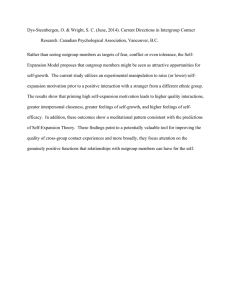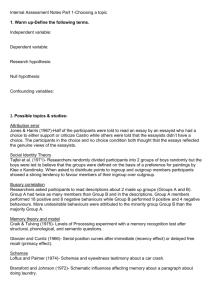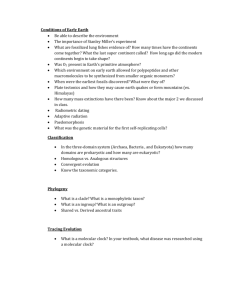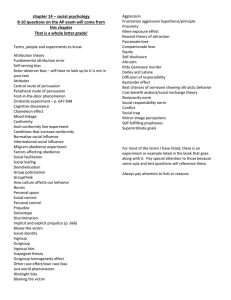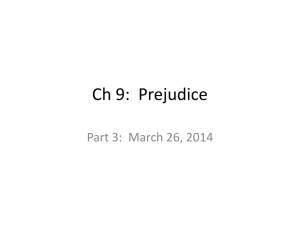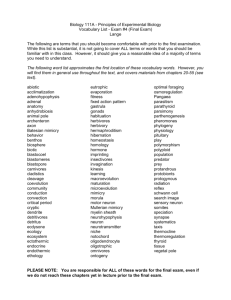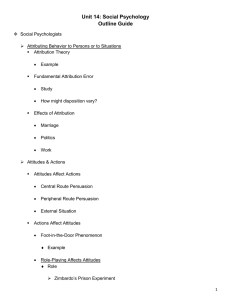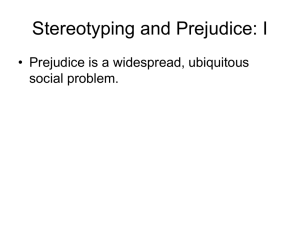This article appeared in a journal published by Elsevier. The... copy is furnished to the author for internal non-commercial research
advertisement
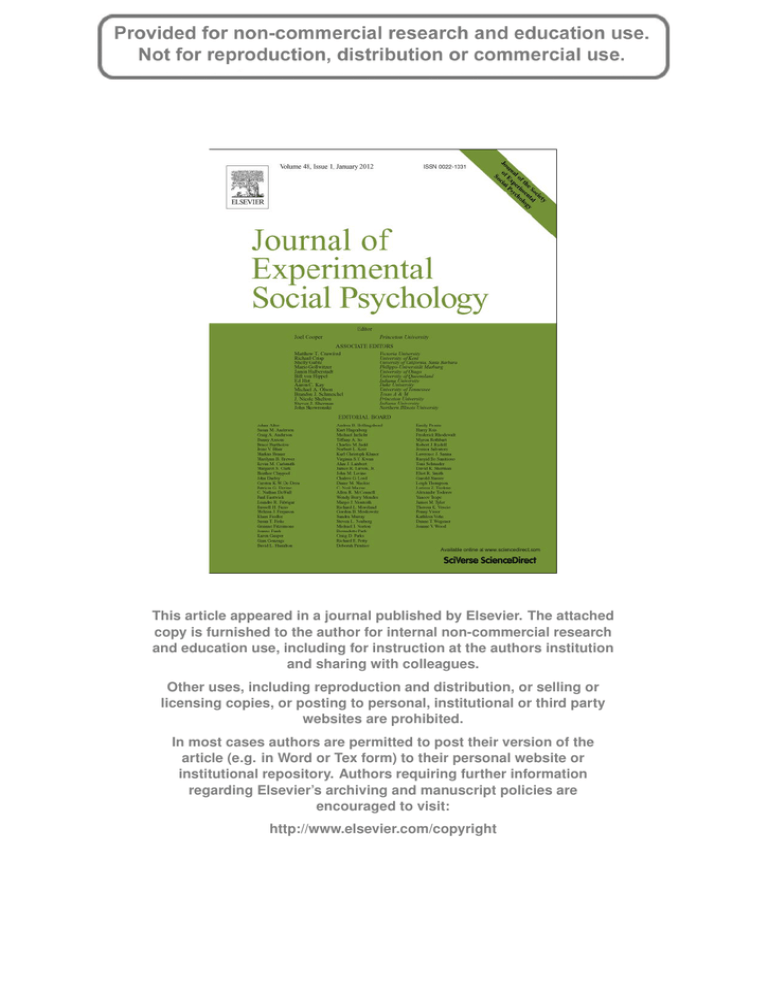
This article appeared in a journal published by Elsevier. The attached copy is furnished to the author for internal non-commercial research and education use, including for instruction at the authors institution and sharing with colleagues. Other uses, including reproduction and distribution, or selling or licensing copies, or posting to personal, institutional or third party websites are prohibited. In most cases authors are permitted to post their version of the article (e.g. in Word or Tex form) to their personal website or institutional repository. Authors requiring further information regarding Elsevier’s archiving and manuscript policies are encouraged to visit: http://www.elsevier.com/copyright Author's personal copy Journal of Experimental Social Psychology 48 (2012) 361–365 Contents lists available at ScienceDirect Journal of Experimental Social Psychology j o u r n a l h o m e p a g e : w w w. e l s ev i e r. c o m / l o c a t e / j e s p FlashReport Mimicry reduces racial prejudice Michael Inzlicht ⁎, Jennifer N. Gutsell, Lisa Legault Department of Psychology, University of Toronto Scarborough, Toronto, Canada ON M1C 1A4 a r t i c l e i n f o Article history: Received 26 March 2011 Revised 6 June 2011 Available online 21 June 2011 Keywords: Prejudice Mimicry Empathy Implicit prejudice Social neuroscience a b s t r a c t Humans are empathic animals. We automatically match other people's motor responses, allowing us to get “under the skin” of other people. Although this perception–action-coupling—a form of motor resonance— occurs spontaneously, this happens less readily with the outgroup (vs. the ingroup) and for those high (vs. low) in prejudice. Thus, prejudice diminishes our tendency to resonate with the outgroup. Here we suggest that the reverse is also possible—that resonating with the actions of an outgroup member can reduce prejudice. We predict, in other words, that explicitly mimicking the outgroup can reduce prejudice. Participants watched a 140-second video depicting actors repeatedly reaching for and drinking from a glass of water. They passively watched a video with Black actors; watched the video and mimicked the Black actors; or watched and mimicked a video with actors from their ingroup. Participants then completed the Affect Misattribution Procedure (Payne, Cheng, Govorun, & Stewart, 2005), a measure of implicit anti-Black prejudice, and an explicit symbolic racism measure. Results indicate that the outgroup-mimicry group had similar implicit preference for Blacks and Whites, unlike the other two groups, which preferred Whites over Blacks. The outgroup-mimicry group also reported less explicit racism towards Blacks than the ingroupmimicry group, but no less than the ingroup-observation group. Mimicking specific outgroup members, therefore, reduces implicit, and possibly explicit, bias against the outgroup more generally. © 2011 Elsevier Inc. All rights reserved. Introduction The neuroscience of the empathy gap Humans are empathic animals. Basic research in neuroscience has established that we readily connect with others. We automatically match other people's motor and autonomic responses, thereby allowing us to get “under their skin,” and understand their emotions and needs. At the core of this empathic capacity lies a brain mechanism that couples the perception of another's behavior with one's own neural representations of that behavior. This perception– action-coupling or motor resonance is grounded in basic neurophysiology and results in people not only mentally simulating, but also mimicking the actions and emotions of others. It turns out, however, that this empathic capacity is constrained by social factors, most notably attitude and group membership. Whites, for example, are less likely to mentally resonate with Blacks, especially if they are high in prejudice (Gutsell & Inzlicht, 2010). Prejudice, then, is associated with a reduction in the degree to which we spontaneously resonate with, and therefore simulate and mimic the motor actions of outgroups (Yabar, Johnson, Miles, & Peace, 2006). Here we explore if the reverse is also possible, if resonating with the actions of an outgroup member can reduce prejudice. A number of neuroscience studies have documented that although we may automatically resonate with others (De Waal, 2008; Decety & Jackson, 2004), this happens less readily with people who belong to the outgroup. For example, measuring electroencephalographic (EEG) oscillations over motor cortex, Gutsell and Inzlicht (2010) found that although White participants generated significant motor activity when observing Whites perform an action, they showed no such activity when observing South Asians or Blacks. Similarly, activation in neural areas involved in the experience of pain is lower when people observe ethnic outgroup members in pain compared to ethnic ingroup members (Avenanti, Sirigu, & Aglioti, 2010; Xu, Zuo, Wang, & Han, 2009). Finally, although people of various ethnic backgrounds emotionally resonate with their ingroup, showing EEG oscillations associated with distress and withdrawal when observing ingroup others in distress, they are less likely to do so when observing outgroup others (Gutsell & Inzlicht, 2011). All told the perception-action-mechanism, thought to be so important for our empathic capacity, appears to be constrained to the ingroup (Mathur, Harada, Lipke, & Chiao, 2010). Rather than reflecting innate ingroup preferences, however, such ingroup biases may occur as a function of culturally-learned racial prejudice (Chiao & Mathur, 2010). High-prejudice participants, for example, are especially likely to show diminished perception–action-coupling to the outgroup, be that diminished motor cortex activity (Gutsell & Inzlicht, ⁎ Corresponding author at: University of Toronto, Department of Psychology, 1265 Military Trail Toronto, Ontario, Canada M1C 1A4. Fax: + 1 416 287 7642. E-mail address: michael.inzlicht@utoronto.ca (M. Inzlicht). 0022-1031/$ – see front matter © 2011 Elsevier Inc. All rights reserved. doi:10.1016/j.jesp.2011.06.007 Author's personal copy 362 M. Inzlicht et al. / Journal of Experimental Social Psychology 48 (2012) 361–365 2010), or less avoidance-related frontal asymmetry (Gutsell & Inzlicht, 2011). Can explicit perception–action-coupling reduce prejudice? Prejudice, then, reduces perception–action-coupling to the outgroup. Our central question is if the reverse also true—can perception– action-coupling reduce prejudice? If people explicitly match their perception of individual outgroup members with their own actions— that is, if they mimic outgroup members—will they show less prejudice towards that outgroup as a whole? Although there is now a substantial body of research on human mimicry (Chartrand & van Baaren, 2009), to our knowledge, no one has addressed this issue directly. We know that we unconsciously mimic others' postures and mannerisms (Chartrand & Bargh, 1999) and limit our mimicry to those in the ingroup (Yabar, Johnson, Miles & Peace, 2006). We also mimic people when we want to affiliate with them (Lakin & Chartrand, 2003), and we like and act more prosocially toward people who mimic us (van Baaren, Holland, Kawakami, & van Knippenberg, 2004). There are also suggestions that mimicry is implemented by the recruitment of the mirror neuron system (Obhi & Hogeveen, 2010). We do not know, however, if mimicry can reduce bias toward devalued racial outgroups; if mimicking a few outgroup members could reduce unconscious bias not only towards the people who were specifically mimicked, but also toward the outgroup as a whole. Study overview Non-Black participants were instructed to watch a video of a number of people performing a generic motor task. In the main experimental condition, participants viewed a video with Black actors and were further instructed to mimic the actions of the actors. In one of the control conditions, participants passively watched the video of Black actors; and in a second control condition, participants watched and mimicked actors who belonged to their ingroup. Unlike most studies that use nonconscious mimicry (e.g., Chartrand & Bargh, 1999), this manipulation is consistent with work using intentional forms of mimicry (e.g., Stel et al., 2009). After the mimicry manipulation, participants then completed implicit and explicit measures of anti-Black prejudice. We predicted that mimicking the outgroup would result in less explicit and implicit prejudice than passively observing the outgroup or than mimicking the ingroup. Method Participants Sixty-three non-Black undergraduates (37 female, 26 male; Mage = 18.85, SD = 18.85, SD = 2.25) participated in exchange for course credit and were randomly assigned to one of three betweensubject conditions: Outgroup mimicry, outgroup observation, and ingroup mimicry. Procedure Upon entering the lab, participants were randomly assigned to one of the three between-subject conditions that involved watching a 140-second video depicting university-aged male actors sitting at a table with a glass of water and then repeatedly reaching for the glass, taking a small sip of water, and then putting the glass back down (see Fig. 1). In the outgroup-mimicry condition, participants were seated at a table with a glass of water and watched a video of seven different Black actors each performing the action for 20 s. Critically, participants were instructed to match their perception of each actor with their own glass-reaching/water-drinking action. To control for mere observation of the outgroup, in the outgroup-observation condition, participants saw the same video with Black actors, but did not mimic the actors. To control for mimicry, in the ingroup-mimicry condition, participants saw and mimicked a video depicting seven different (ideographically-chosen) ingroup members. The actors in the videos were matched on attractiveness and likability (Gutsell & Inzlicht, 2010). After watching and (in two conditions) mimicking the actions in the videos, participants completed two measures of anti-Black prejudice, one implicit and one explicit. Measures Affect misattribution paradigm (AMP) We measured implicit anti-Black prejudice with the AMP, which assesses the strength of automatic evaluations of the Black and White racial category (Payne, Cheng, Govorun, & Stewart, 2005). The AMP consisted of 72 trials, with each trial presenting either a White or Black unfamiliar face for 75 ms, and then an unfamiliar pictogram (a character from the Glagolitic alphabet) for 125 ms followed by a mask which remained on the screen till the beginning of the next trial (see Fig. 1). Participants were instructed to ignore the first image, but to indicate whether they did or did not like the pictogram by pressing the appropriate key. We used separate ratio scores for both Black and White faces (e.g. number of positive ratings after Black faces divided by total of ratings after Black face) as an indication of implicit group preference, with higher scores indicating greater preference. Symbolic racism 2000 scale Participants completed the Symbolic Racism Scale (Henry & Sears, 2002)—an explicit measure of modern racism, indicative of a subtle form of racism that obscures racist feelings with abstract values, such as justice and order. Results We submitted the AMP-ratio scores to a 3 (outgroup-mimicry vs. outgroup-observation vs. ingroup-mimicry) × 2 (Black vs. White) mixed-model ANOVA, with the last factor repeated. Results indicate greater implicit preference for Whites, F (1, 60) = 5.45, Prep = .92, d = .60, replicating past work (Payne et al., 2005). Importantly, Fig. 2a illustrates an interaction, F (2, 60) = 2.86, prep = .90, η 2p = .087, suggesting that the outgroup-mimicry group showed similar preference for Blacks (M = .53, SD = .19) as for Whites (M = .51, SD = .18), t (24), ns, which is a pattern significantly different from that observed with both the ingroup-mimicry and outgroup-observation groups, t (60) = 2.33, prep = .95, d = .60. These latter two groups, in contrast, implicitly preferred Whites to Blacks (ingroup-mimicry: MWhite = .58, SD = .16 vs. MBlack = .46, SD = .21, t(18) = 2.08, prep = .88, d = .64; outgroup-observation: MWhite = .49, SD = .22 vs. MBlack = .41, SD = .21, t(18) = 2.28, prep = .90, d = .37). Mimicking Black people, then, reduced implicit bias against Blacks over and above simply observing Blacks or mimicking other people more generally. Another way to breakdown the interaction between condition and target race is to examine the effect across conditions separately for both Black and White target groups. Planned contrast analyses revealed that the outgroup-mimicry group showed higher implicit evaluations of Blacks than the other two groups, t (60) = −1.84, prep = .90, d = .48. The latter groups did not differ from one another, t (60) b 1, ns. In contrast, outgroup-mimicry did not change implicit evaluations of Whites compared to the other two groups, t (60) = .60, ns, with these latter two groups also not differing significantly, t (60)= 1.53, prep b .79. Consistent with our predictions, mimicking the outgroup increased implicit evaluations of Blacks, but had no effect on evaluations of Whites. The effect of mimicry on explicit prejudice also supported our predictions. We submitted the symbolic racism scores to a betweensubjects conditions (outgroup-mimicry vs. outgroup-observation vs. Author's personal copy M. Inzlicht et al. / Journal of Experimental Social Psychology 48 (2012) 361–365 363 Fig. 1. Schematic of experimental procedures. ingroup-mimicry) ANOVA, with results indicating a significant main effect for condition, F(2, 60) = 4.87, p = .011, η 2p = .14. Critically, Fig. 2 illustrates a significant difference between the outgroup-mimicry (M = 2.21, SD = .33) and ingroup-mimicry groups (M = 2.57, SD = .49), prep = .97, d = .87. Surprisingly, the outgroup-observation group had similar levels of modern racism (M = 2.24, SD = .40) as the outgroup-mimicry group, ns, but not the ingroup-mimicry group, prep = .94, d = .74. Thus, mimicking the outgroup appears to reduce conscious reports of prejudice. However, given the finding that merely observing the outgroup does the same, it suggests that we should treat results of the explicit measure with some suspicion, as demand characteristics may have played a role. Discussion Mimicking outgroup members, therefore, reduces implicit bias against that outgroup. This effect cannot be attributed to merely observing outgroups or to some general effect of mimicking other people; rather the effect only occurred when people mimicked the outgroup. What is also interesting is that the effect of mimicking specific outgroup exemplars generalized to the whole outgroup, reducing bias to a completely different set of outgroup exemplars. Another broader possibility is that mimicry increases implicit preference for any group that is mimicked, not just the outgroup. Although it was not significant, our data indicate that mimicking the Fig. 2. (A) Implicit preferences (as measured by AMP ratio scores) for Black and White faces and (B) explicit scores on the symbolic racism scale as a function of experimental condition. Author's personal copy 364 M. Inzlicht et al. / Journal of Experimental Social Psychology 48 (2012) 361–365 ingroup had a tendency to increase evaluations of Whites. Future work is therefore needed to establish if this effect is robust and if mimicry of any group, even the ingroup, functions to increase implicit preferences for that group. Mimicking the outgroup also appears to reduce consciouslyreportable prejudice, although here the mere observation does the same. It is therefore unclear whether mimicry and observation legitimately reduce explicit prejudice, or whether these results are artifacts of increased self-presentation. Future research will be needed to disambiguate these alternative possibilities. Self-other overlap Mimicry reduces implicit, and possibly explicit, forms of prejudice. But why? Although we did not measure process variables, past research on mimicry and on the methods to reduce prejudice indicate a common mechanism: self-other overlap. Self-other overlap can be defined as the overlap between mental representations of the self and mental representations of another person or group (Davis, Conklin, Smith, & Luce, 1996). Critically, research suggests that mimicry increases self-other overlap and that stereotyping and prejudice reduce it. First, there is a robust connection between mimicry and construing the world in terms of the relationships we have with other people (Galinsky, Ku, & Wang, 2005). For example, people who have been experimentally primed to construe themselves in terms of their personal relationships (van Baaren, Maddux, Chartrand, de Bouter, & van Knippenberg, 2003) tend to routinely mimic others' behaviors. Further, being mimicked during social interactions leads to more interdependent and “other-oriented” self-construals, an effect that further mediates the relationship between mimicry and pro-sociality (Ashton-James, van Baaren, Chartrand, & Decety, 2007). Mimicry, it seems, is associated with an increase in self-other overlap. Second, although many forms of prejudice reduction techniques now abound, one factor that may unite many of them is an increase in self-other overlap. For example, perspective-taking, or putting oneself in the shoes of another, can reduce stereotyping and prejudice, and does so by increasing self-other overlap (Galinsky & Moskowitz, 2000; Vescio, Sechrist, & Paolucci, 2003). Training people to approach the outgroup can similarly reduce prejudice on response latency as well as neurophysiological measures and does so by increasing the association between the self and the outgroup (Phills, Kawakami, Tabi, Nadolny, & Inzlicht, 2011). Finally, research on cross-group friendships indicates that such friendships can reduce prejudice with novel outgroup members and does so by an increased association of the friend's ethnicity with the self (Page-Gould, Mendoza-Denton, Alegre, & Siy, 2010). Increasing self-other overlap, it appears, is a powerful means to reduce prejudice. Our findings are also consistent with research in the neuroscience of empathy. There is now mounting evidence that mimicry activates the same neural systems thought to implement perception–action coupling, namely the mirror neuron system (Obhi & Hogeveen, 2010). Thus, mimicry kick-starts the brain system that underlies motor resonance. And it is precisely this motor resonance that is lacking for outgroups and for those we are biased against (Gutsell & Inzlicht, 2010). By having people artificially resonate with outgroup members —by having them mimic outgroup others—we are in effect priming the kind of perception–action-coupling that is normally absent for the outgroup, but present for the ingroup, and so important for empathy and liking. Although ours is the first to examine the impact of mimicry on prejudice reduction, others have examined the interaction of mimicry and stereotyping. What is interesting about this other work is that it indicates that mimicry is associated with a perpetuation of stereotypes. For example, people who are mimicked tend to act in accordance with the stereotypes that others hold for them (Leander, Chartrand, & Wood, 2010). Further, people who express stereotypical attitudes tend to be mimicked more than those expressing nonstereotypical attitudes (Castelli, Pavan, Ferrari, & Kashima, 2009). Thus, the relationship between mimicry and stereotyping/prejudice is complex: it sometimes reinforces stereotypical behavior, but sometimes reduces prejudice. Future research is needed to explore the boundary conditions of these effects. Conclusion Even if humans are empathic creatures, this empathy is constrained by culturally-learned factors. Specifically, we are less likely to mirror the actions and emotions of outgroups when we show strong bias against these outgroups, be that less mental simulation or behavioral mimicry. So bias limits mirroring. Here, however, we show the plasticity of this gap. Even very brief interventions—a 140 s mirroring procedure—can reverse the empathy gap, at least temporarily. The empathy-gap is culturally-learned, and the results of our study suggest that they can be unlearned as well. Acknowledgments This research was supported by grants from the Canada Foundation for Innovation, the Ontario Ministry of Research and Innovation, and the Social Sciences and Humanities Research Council to Michael Inzlicht. We thank Elizabeth Page-Gould, Jason Plaks, Alexa Tullett, Rimma Teper, Shona Tritt, Sonia Kang, Jacob Hirsh, and Naomi Sarah Ball for valuable insights. We also thank Berina Chan, Kaljani Mahalingam, Marlon Mitchell, Tharsiya Nagulesapillai, Shajia Zia, and Jeff Wong for their assistance with data collection. References Ashton-James, C., van Baaren, R., Chartrand, T. L., & Decety, J. (2007). Mimicry and me: The impact of mimicry on self-construal. Social Cognition, 25, 518–535. Avenanti, A., Sirigu, A., & Aglioti, S. M. (2010). Racial bias reduces empathic sensorimotor resonance with other-race pain. Current Biology. doi:10.1016/j.cub.2010.03.071. Castelli, L., Pavan, G., Ferrari, E., & Kashima, Y. (2009). The stereotype and the chameleon: The effects of stereotype use on perceivers' mimicry. Journal of Experimental Social Psychology, 45, 835–839. Chartrand, T. L., & Bargh, J. A. (1999). The chameleon effect: The perception-behavior link and social interaction. Journal of Personality and Social Psychology, 76, 893–910. Chartrand, T. L., & van Baaren, R. (2009). Human Mimicry. Advances in Experimental Social Psychology, 41, 219–274. Chiao, J. Y., & Mathur, V. A. (2010). Intergroup empathy: How does race affect empathic neural responses? Current Biology, 20, 478–480. Davis, M. H., Conklin, L., Smith, A., & Luce, C. (1996). Effect of perspective taking on the cognitive representation of persons: A merging of self and other. Journal of Personality and Social Psychology, 70, 713–726. De Waal, F. B. M. (2008). Putting the altruism back into altruism: The evolution of empathy. Annual Review of Psychology, 59, 279–300. Decety, J., & Jackson, P. (2004). The functional architecture of human empathy. Behavioral and Cognitive Neuroscience Reviews, 3, 71–100. Galinsky, A. D., Ku, G., & Wang, C. S. (2005). Perspective taking and self-other overlap: Fostering social bonds and facilitating social coordination. Group Processes and Intergroup Relations, 8, 109–124. Galinsky, A. D., & Moskowitz, G. B. (2000). Perspective-taking: Decreasing stereotype expression, stereotype accessibility, and in-group favoritism. Journal of Personality and Social Psychology, 78, 708–724. Gutsell, J. N., & Inzlicht, M. (2010). Empathy constrained: Prejudice predicts reduced mental simulation of actions during observation of outgroups. Journal of Experimental Social Psychology, 46, 41–845. Gutsell, J. N., & Inzlicht, M. (2011). Intergroup differences in the sharing of emotive states: Neural evidence of an empathy gap. Social Cognitive Affective Neuroscience doi:10.1093/scan/nsr035. Henry, P. J., & Sears, D. O. (2002). The symbolic racism 2000 scale. Political Psychology, 23, 253–283. Lakin, J., & Chartrand, T. L. (2003). Using nonconscious behavioral mimicry to create affiliation and rapport. Psychological Science, 14, 334–339. Leander, N. P., Chartrand, T. L., & Wood, W. (2010). Mind your mannerisms: Behavioral mimicry elicits stereotype conformity. Journal of Experimental Social Psychology, 47, 195–201. Mathur, V. A., Harada, T., Lipke, T., & Chiao, J. Y. (2010). Neural basis of extraordinary empathy and altruistic motivation. NeuroImage, 51, 1458–1475. Author's personal copy M. Inzlicht et al. / Journal of Experimental Social Psychology 48 (2012) 361–365 Obhi, S. S., & Hogeveen, J. (2010). Incidental action observation modulates muscle activity. Experimental Brain Research, 203, 427–435. Page-Gould, E., Mendoza-Denton, R., Alegre, J. M., & Siy, J. O. (2010). Understanding the impact of cross-group friendship on interactions with novel outgroup members. Journal of Personality and Social Psychology, 98, 775–793. Payne, B. K., Cheng, C. M., Govorun, O., & Stewart, B. D. (2005). An inkblot for attitudes: Affect misattribution as implicit measurement. Journal of Personality and Social Psychology, 89, 277–293. Phills, C. E., Kawakami, K., Tabi, E., Nadolny, D., & Inzlicht, M. (2011). Mind the gap: Increasing associations between the self and Blacks with approach behaviors. Journal of Personality and Social Psychology, 100, 197–210. Stel, M., Blascovich, J., McCall, C., Mastop, J., van Baaren, R. B., & Vonk, R. (2009). Mimicking disliked others: Effects of a priori liking on the mimicry-liking link. European Journal of Social Psychology, 40, 867–880. 365 van Baaren, R. B., Holland, R. W., Kawakami, K., & van Knippenberg, A. (2004). Mimicry and pro-social behavior. Psychological Science, 15, 71–74. van Baaren, R. B., Maddux, W. W., Chartrand, T. L., de Bouter, C., & van Knippenberg, A. (2003). It takes two to mimic: Behavioral consequences of self-construals. Journal of Personality and Social Psychology, 84, 1093–1102. Vescio, T. K., Sechrist, G. B., & Paolucci, M. P. (2003). Perspective taking and prejudice reduction: The mediational role of empathy arousal and situational attributions. European Journal of Social Psychology, 33, 455–472. Xu, X., Zuo, Z., Wang, W., & Han, S. (2009). Do you feel my pain? Racial group membership modulates empathic neural responses. The Journal of Neuroscience, 29, 8525–8529. Yabar, Y., Johnson, L., Miles, L., & Peace, V. (2006). Implicit behavioral mimicry: Investigating the impact of group membership. Journal of Nonverbal Behavior, 30, 97–113.
